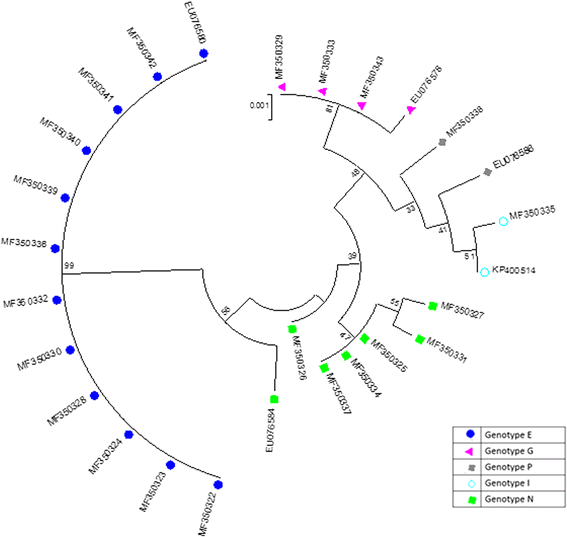Molecular typing of Trichomonas vaginalis isolates by actin gene sequence analysis and carriage of T. vaginalis viruses
- PMID: 29084570
- PMCID: PMC5663105
- DOI: 10.1186/s13071-017-2496-7
Molecular typing of Trichomonas vaginalis isolates by actin gene sequence analysis and carriage of T. vaginalis viruses
Abstract
Background: The protozoan parasite Trichomonas vaginalis is the most common non-viral, sexually transmitted pathogen. Although T. vaginalis is highly prevalent among women in Kenya, there is lack of data regarding genetic diversity of isolates currently in circulation in Kenya.
Methods: Typing was performed on 22 clinical isolates of T. vaginalis collected from women attending the antenatal care clinic at Kilifi County Hospital, Kenya, in 2015. Genotyping followed a previously proposed restriction fragment length polymorphism (RFLP) scheme, which involved in silico cleavage of the amplified actin gene by HindII, MseI and RsaI restriction enzymes. Phylogenetic analysis of all the sequences was performed to confirm the results obtained by RFLP-analysis and to assess the diversity within the RFLP genotypes. Additionally, we determined carriage of the four different types of Trichomonas vaginalis viruses (TVVs) by polymerase chain reaction.
Results: In silico RFLP-analysis revealed five actin genotypes; 50.0% of the isolates were of actin genotype E, 27.3% of actin genotype N, 13.6% of actin genotype G and 4.5% of actin genotypes I and P. Phylogenetic analysis was in agreement with the RFLP-analysis, with the different actin genotypes clustering together. Prevalence of TVVs was 43.5% (95% confidence interval, CI: 23.2-65.5). TVV1 was the most prevalent, present in 39.1% of the strains and 90% of the T. vaginalis isolates which harbored TVVs had more than one type of TVV. None of the isolates of actin genotype E harbored any TVV.
Conclusion: The presence of five actin genotypes in our study suggests notable diversity among T. vaginalis isolates occurring among pregnant women in Kilifi, Kenya. Isolates of the most prevalent actin genotype E lacked TVVs. We found no association between T. vaginalis genotype, carriage of TVVs and symptoms. Further studies with higher number of strains should be conducted in order to corroborate these results.
Keywords: Kenya; Kilifi; Trichomonas vaginalis; Trichomonas vaginalis viruses; Typing; actin gene.
Conflict of interest statement
Ethics approval and consent to participate
The study was approved by the Kenya Medical Research Institute (KEMRI) Scientific and Ethics Review Unit (#3022). All participants provided written informed consent for study participation.
Consent for publication
Not applicable.
Competing interests
The authors declare that they have no competing interests.
Publisher’s Note
Springer Nature remains neutral with regard to jurisdictional claims in published maps and institutional affiliations.
Figures

References
-
- Newman L, Rowley J, Vander Hoorn S, Wijesooriya NS, Unemo M, Low N, et al. Global estimates of the prevalence and incidence of four curable sexually transmitted infections in 2012 based on systematic review and global reporting. PLoS One. 2015;10:e0143304. doi: 10.1371/journal.pone.0143304. - DOI - PMC - PubMed
MeSH terms
Substances
Grants and funding
LinkOut - more resources
Full Text Sources
Other Literature Sources

